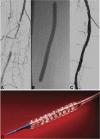An update on vessel preparation in lower limb arterial intervention
- PMID: 33245456
- PMCID: PMC7695779
- DOI: 10.1186/s42155-020-00175-6
An update on vessel preparation in lower limb arterial intervention
Abstract
Background: Plain balloon angioplasty has traditionally been used to treat lower limb arterial disease but can be limited by significant residual stenosis, vessel recoil, dissection, and by late restenosis. Appropriate vessel preparation may significantly improve short and long-term outcomes. We aim to give an overview of some of the devices currently available, or under investigation, for vessel preparation in the lower limb.
Main text: Vessel preparation devices include those that remove plaque (atherectomy devices) and those that modify plaque. The four groups of plaque removing atherectomy devices are defined by their plaque removal method: Directional, rotational orbital and excimer laser are categories of devices investigated for plaque modification. Intravascular lithotripsy devices generate sonic pulsatile pressure waves that pass into the vessel wall cracking calcified plaques whilst sparing soft tissue. This enables dilatation of calcified lesions at low pressure by conventional balloons and enables full stent expansion. Other balloon based vessel preparation devices were designed to modify plaque and produce more controlled, lower pressure luminal expansion without major dissections and potentially with less recoil than conventional angioplasty balloons. Scoring balloons have a helical nitinol element attached to the balloon that scores plaque facilitating uniform luminal enlargement. Further specialty balloons have been developed in recent years, including the Chocolate, Phoenix and Serranator balloons. Finally, the temporary Spur self-expanding retrievable nitinol stent has a series of radially aligned spurs that are driven into the vessel wall by post-dilatation, potentially improving drug delivery.
Conclusion: Lesion specific vessel preparation aims to improve both short and long term outcomes through improved penetration of anti-proliferative drug, maximising luminal gain, reducing the need for stent placement and minimising intimal injury. Some forms of vessel preparation appear to improve short term outcomes; long-term outcomes remain uncertain. An overview of some of the multiple devices available for vessel preparation is presented.
Keywords: Atherectomy; Cutting balloon; Intravascular lithotripsy; Peripheral arterial disease; Scoring balloon, specialty balloon, chocolate balloon, Serranator balloon, spur stent, drug-coated balloon; Vessel preparation.
Conflict of interest statement
The authors declare they have no competing interests
Figures





References
-
- A Critical View of the Peripheral Atherectomy Data in the Treatment of Infrainguinal Arterial Disease. In: J. Invasive Cardiol. https://www.invasivecardiology.com/articles/critical-view-peripheral-ath.... Accessed 10 Sept 2020. - PubMed
-
- Beschorner U, Krankenberg H, Scheinert D, et al. Rotational and aspiration atherectomy for infrainguinal in-stent restenosis. Vasa. 2013. - PubMed
LinkOut - more resources
Full Text Sources
